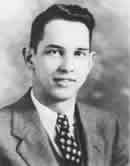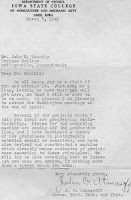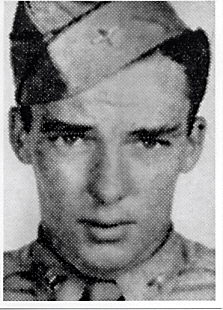Well, did
you know the inventor of the personal computer, the Atanasoff Berry Computer (ABC),
was John Vincent Atanasoff, and was buried at the Pine Grove Chapel in Mount
Airy, MD in 1995?
And that the principles of John
Atanasoff's computer are the basis of millions of computers and the information
revolution, without which modern society would not exist? 

The big breakthrough
was made by John Atanasoff who abandoned mechanics and designed electronic
circuits for calculating by use of a binary system of numbers.
That you do not know may not be an
accident given that Atanosoff’s invention plans was stolen from him in
1938 and used by Sperry Univac.
He had to sue for years to prove in court that
he, and not Sperry Univac, was the true inventor of the personal computer.
 In 1937, a professor of mathematics and
physics went for a long drive to Illinois during which he conceived several
ideas that still change the world.
In 1937, a professor of mathematics and
physics went for a long drive to Illinois during which he conceived several
ideas that still change the world. These ideas led Professor John Vincent
Atanasoff (together with his PhD assistant Clifford Edward Berry) to invent and
build the Atanasoff Berry Computer (ABC), the first DIGITAL electronic computer.
They built it in the basement of the
physics building at Iowa State College during
1939–42. He was driven by the need to solve physics problems using long numeric
equations.
Among the breakthroughs that John Atanasoff made were the
following ideas, all of which he jotted down on a napkin in
a tavern.
- Electricity and
electronics, not mechanical methods
- Binary numbers
internally
- Separate memory made
with capacitors, refreshed to maintain 0 or I state
- Direct 0-1 logic
operations, not enumeration
From these ideas, he was able to successfully build the
ABC. The ENIAC successor, and all subsequent computers, are based on these
ideas.
For memory, the ABC used electrostatic
store-drums made up of 1600 capacitors each.
These capacitors are used to store
a small charge representing the 1, or on, state. The off, or 0, state was
represented by no charge.
Therefore, binary numbers could be stored onto the
drums.
 This is the first use of the idea now known as DRAM, a modern day
technology used in today’s computers.
This is the first use of the idea now known as DRAM, a modern day
technology used in today’s computers.
The ABC was a specific-use computer,
designed to solve systems of linear algebraic equations, and was capable of
solving systems with up to 29 unknowns.
What is remarkable about John
Atanasoff’s computer is that he created it on his own, with no real financial
backing from companies or the government like future projects such as the
ENIAC, EDVAC or UNIVAC.
In 1942, John Atanasoff was called on
duty and he started a defence-related position in the Naval Ordnance Laboratory
in White Oak, MD, as a theoretical physicists to work on various projects
related to mines disarming, underwater bombs, and rockets. He participated in
the atomic bomb tests at Bikini Atoll n 1946.
John Vincent Atanasoff's papers are archived here.
John Vincent Atanasoff's papers are archived here.
He holds patents to over 30
different devices (for a device for capturing and recording seismic sound
waves, a post office sorting system, automated systems for package preparation
and others).
In 1973, after a Federal patent judge
voided a patent owned by Sperry Rand Corp. on ENIAC,
the Atanasoff-Berry Computer was credited as the first electronic digital computer.
This decision put the
invention of the electronic digital computer in the public domain and granted
legal recognition to John Atanasoff as the inventor of the first electronic
digital computer.
Following World War II, John Atanasoff remained with the
government and developed specialized seismographs and microbarographs for
long-range explosive detection. In 1952, he founded and led the Ordnance
Engineering Corporation, selling the company to Aerojet General Corporation in
1956 and becoming Aerojet's Atlantic Division president.
 In 1960, he and his wife Alice moved to their farm in New
Market, MD. In 1961, he started another company, Cybernetics in Frederick
that he operated for 20 years. In 1970, John Atanasoff was invited to Bulgaria (his
father John emigrated to the U.S. in 1889 at 13 from Bulgaria) by the Bulgarian
Academy of Sciences, and the Bulgarian Government conferred to him the Cyrille
and Methodius Order of Merit First Class. President George H.W. Bush awarded
him the National Medal of Science and Technology in 1990.
In 1960, he and his wife Alice moved to their farm in New
Market, MD. In 1961, he started another company, Cybernetics in Frederick
that he operated for 20 years. In 1970, John Atanasoff was invited to Bulgaria (his
father John emigrated to the U.S. in 1889 at 13 from Bulgaria) by the Bulgarian
Academy of Sciences, and the Bulgarian Government conferred to him the Cyrille
and Methodius Order of Merit First Class. President George H.W. Bush awarded
him the National Medal of Science and Technology in 1990.
Inventor of the digital computer, father of the modern
computer, WWII war research victory contributor, company founder, husband,
father, immigrant’s son…the man who quietly revolutionized the world…and then
for years had to defend the theft of his invention from very powerful companies
in multiple lawsuits.
His life and work contributed mightily to the American
Dream.
An immigrant’s son who knew genius required grit to succeed. We all,
especially everyone who has used a computer, owe him a huge debt of gratitude.
| New Market's John V. Atanasoff helped spark the computer age |
| February 21, 2002, Gazette, Karen Beck, Staff Writer. |
John Vincent Atanasoff lived in a home on the east side of New Market for over 30 years, watching the countryside change just like everyone else in Frederick County. Unlike everyone else, however, Atanasoff happened to have invented one of the key technological advances of the modern age. His calculating machine, created over 60 years ago at Iowa State College (now University), was ruled in 1972 to be the first in a long line of evolution that most recently has churned out Pentium processors and G4s. For that reason, Atanasoff is credited with being the computer's inventor, and today, seven years after his death, is called its forgotten father. 
So why, then, is Atanasoff not a household name? The reason is that Atanasoff only got credit for his original idea after decades of other people claiming it as their own.
According to some of the many biographies of Atanasoff, the highly-contested inspiration for his rudimentary computer came to Atanasoff in 1937, when he was a professor at Iowa State College. One night as he struggled with the problem of designing a device that could quickly solve complex math problems, he went for a long drive and ended up a tavern in Illinois. Over a shot of bourbon, he realized some of the inherent principles of his invention: he could use electronic, rather than mechanical, components for the device, and use the base-2, binary system.
For three years, Atanasoff worked on this new computer with a graduate student, Clifford Berry. By December of 1939, they had built a promising prototype of the Atanasoff Berry Computer (ABC), which intrigued many people, including one scientist named Dr. John Mauchly. Atanasoff readily talked with Dr. Mauchly about the prototype, and even had him as a houseguest at his home in Iowa.
In the following years as World War II erupted, Atanasoff was sent to Washington to do research for the Naval Ordinance Laboratory. He tried to get a patent for his device, however because of high turnover, the documents were "shoved back in a drawer and forgotten," said William O'Toole, computer science professor at Mount St. Mary's College and long-time friend of Atanasoff.
Submitted photo taken by Carolyn Kaddis John V. Atanasoff, New Market resident and inventor of the computer, at age 80
Meanwhile, Mauchly and Dr. Presper Eckert Jr. developed the now-famous machine called ENIAC and sold it to the U.S. Army. As time went on, Mauchly and Eckert gained the patents and the credit for the first electronic digital computer. From that technology evolved many of the modern devices we use today, from cell phones to Imacs, while the ABC was dismantled to make more space in the Iowa State lab. Atanasoff got other jobs, and in 1963 Berry was found dead in Coney Island, a case O'Toole said the court ruled was a suicide.
It was three decades after the idea's fruition when the matter mushroomed into a three-year-long court case. One computer industry giant, Honeywell Corp., sued another corporation, Sperry Rand Corp., trying to invalidate the Mauchly-Eckert patents it owned. During those deliberations, Atanasoff gave testimony that brought all of Mauchly and Eckert's ideas into question. After a massive investigation, the judge found that the ENIAC computer relied on innovations made in Atanasoff's prototype, in other words, that it was Atanasoff who invented the first computer.
However, this was not news to Atanasoff's wife, Alice. During all the years in which his invention went unrecognized, she said they thought it was "just the way life was." This disappointment did not stop Atanasoff from further accomplishments and inventions. Alice said that he held 32 patents, some of which came from his days working for the government during WWII. Of those, some are still classified. He worked successfully at a number of jobs and operated a engineering business called Cybernetics, Inc. in Frederick for almost 20 years.
Once the announcement was made that the computer was his idea, Alice Atanasoff said that they had hoped for more fanfare. Only with time was he was decorated with awards and accolades, including the National Medal of Technology, presented at a ceremony at the White House. Iowa State University named a hall after him, and in 1997 rebuilt his ABC computer at a cost of $300,000.
"He really opened up the computer industry, competition came in at that point," O'Toole said. O'Toole listed five specific developments that Atanasoff was responsible for, four of which were stolen by Mauchly and Eckert. The only one of those five that they did not use in ENIAC was using a binary system for calculations, which O'Toole said is now the industry standard.
In spite of those accomplishments, the Atanasoffs were never to see any of the financial benefits of such a wide-sweeping invention, and even today many textbooks still list Mauchly and Eckert as the original inventors. According to Alice Atanasoff, that is because once people had their beliefs established, they were not going to change their minds.
Still, what people think does not change her husband's impact on technology, and on the people around him. When the lawyers searched his background as part of the suit, she said that they had talked to many of his old acquaintances. "Most thought he was the most brilliant man they ever knew--but fun," she said. O'Toole listed a bevy of great qualities Atanasoff had, including his humor and warm-hearted nature. "I am happy and proud to say we were good friends," O'Toole said.
Alice Atanasoff moved with her husband after his retirement to their farm in New Market in 1960. They chose the area because they both liked the peace of a farm, and the people and atmosphere of Frederick County. Alice Atansoff still lives in their hilltop home, whose modern architecture was partially designed by her husband.
 Although the Atanasoffs were never active in the town government, she said that they had good friends in the area. Alice said that it was interesting for them to watch the changes in the area, as the landscape went from no houses on the horizon to the current development.
Although the Atanasoffs were never active in the town government, she said that they had good friends in the area. Alice said that it was interesting for them to watch the changes in the area, as the landscape went from no houses on the horizon to the current development. After Atanasoff died from a stroke in 1995, he was buried in Pine Grove Cemetery in Mount Airy, where a monument to him still stands.
That cemetery should be the site of some festivities next year in honor of what would have been Atanasoff's 100th birthday in October of 2003, according to Alice Atanasoff. At the same time, a huge celebration is to be held in Bulgaria. Since Atansoff's grandfather was a Bulgarian patriot, that country has a special tie to his accomplishments. As a result, the Bulgarian government will be dedicating a monument, a commemorative coin, and a postage stamp as celebrations are held across the country at the same time as local tribute is paid to the former New Market resident.
|
http://paul.luon.net/essays/HoC-Atanasoff.pdfhttps://www.fredericknewspost.com/news/science_and_technology/years-after-death-computer-inventor-still-celebrated/article_3afbb911-fee1-5722-b51a-3159bd92a0b1.html
https://www.thocp.net/biographies/atanasoff_john.html
https://www.thocp.net/biographies/atanasoff_john.html







